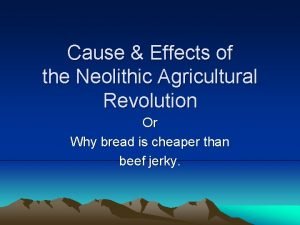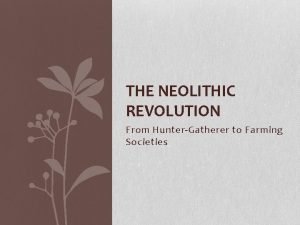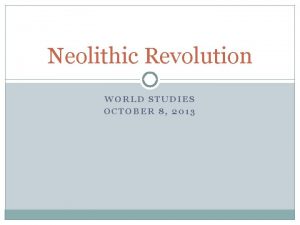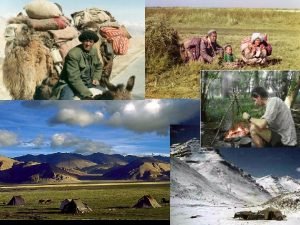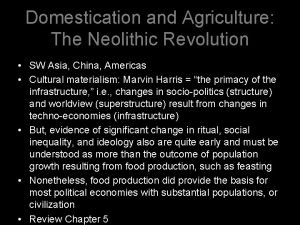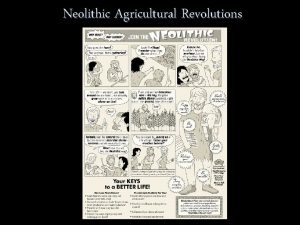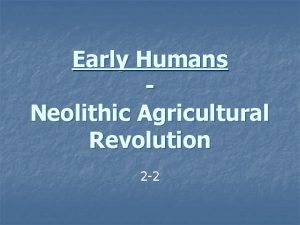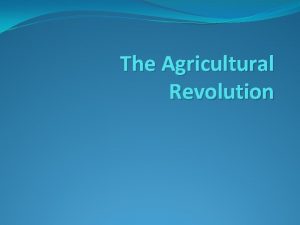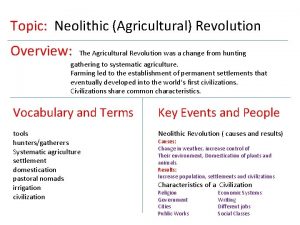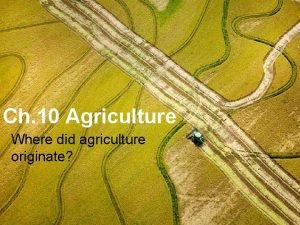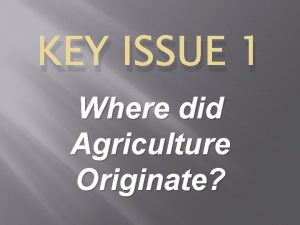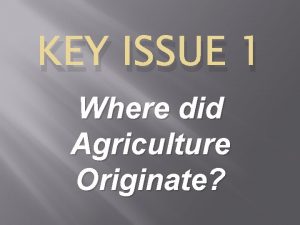Where Did Agriculture Originate Agricultural Revolution Neolithic Revolution










- Slides: 10

Where Did Agriculture Originate? • Agricultural Revolution (Neolithic Revolution) – 10, 000 -8, 000 BCE • The time when humans first domesticated plants and animals and no longer relied entirely on hunting and gathering was known as the agricultural revolution. • Agriculture originated in multiple hearths around the world: • Crop Hearths: • Southwest Asia: • Early crops: barley, wheat, lentil, and olive. • East Asia: • Early crops: Rice and millet.

3 Agricultural Revolutions • First Agricultural Revolution • 10, 000 year ago • The initial domestication of plants and animals • Second Agricultural Revolution • 250 years ago • Mechanization of agriculture with improved practices of cultivation, harvesting, and storage of farm produce. • Third Agricultural Revolution • In progress – Centered around development of Genetically Modified Organisms and chemical fertilizers

Agricultural Revolution (Neolithic Revolution) Primary effects: · Urbanization · Social Stratification · Occupational Specialization · Increased population densities Secondary effects: · Endemic diseases · Famine · Expansionism

2 nd Agricultural Revolution • Lasted from 1700 s to early 1900 s • Coincided with the Industrial Revolution – New technologies developed to improve crop yields • Produced surplus to feed factory workers

Developments of 2 nd Agricultural Revolution • New fertilizer and artificial feed • Selective breeding of livestock • Railroads decreased transportation time • New machines shrunk the number of farmers needed

Third Agricultural Revolution • Began in 1930 s in United States • Spread Mechanization outside of United States after World War II (Green Revolution • Machines get larger, more powerful, and more efficient

Where Did Agriculture Originate? • Comparing Subsistence and Commercial Agriculture • Subsistence agriculture is the production of food primarily for consumption by the farmer’s family. • Practiced primarily in developing countries • Commercial agriculture is the production of food primarily for sale off the farm. • Practiced primarily in developed countries. • Features that distinguish itself from subsistence agriculture include: lower percentage of farmers in labor force, highly mechanized, and larger farm size.

Developments in Third Agricultural Revolution Biotechnological Phase – Inorganic fertilizers and manufactured products replace manure and humus to increase soil fertility – Increasing use of herbicides, pesticides, and fungicides to increase yields

Developments in Third Agricultural Revolution Growth of Agri-Business –a few large corporations own most of the means of agricultural production --increased importance of branding and labels

The Third Agricultural Revolution The Green Revolution • The diffusion of agricultural technologies and practices to less developed countries • Specifically Mexico and Asia (India) • First practiced in 1940 s in Mexico by Rockefeller Foundation IMPACTS • Increased food production in the third world • Changed traditional methods of farming negatively impacting indigenous practices—EX. In the last 20 years, nearly 300, 000 farmers have ended their lives by ingesting pesticides or by hanging themselves
 Key issue 1: where did agriculture originate?
Key issue 1: where did agriculture originate? Neolithic
Neolithic Modern commercial agriculture
Modern commercial agriculture Cause and effect of neolithic revolution
Cause and effect of neolithic revolution Join the neolithic revolution cartoon
Join the neolithic revolution cartoon Neolithic revolution
Neolithic revolution The rise of civilization lesson 2 the neolithic revolution
The rise of civilization lesson 2 the neolithic revolution What was before the stone age
What was before the stone age Whats neolithic revolution
Whats neolithic revolution What was the neolithic revolution? *
What was the neolithic revolution? * Sw asia
Sw asia



